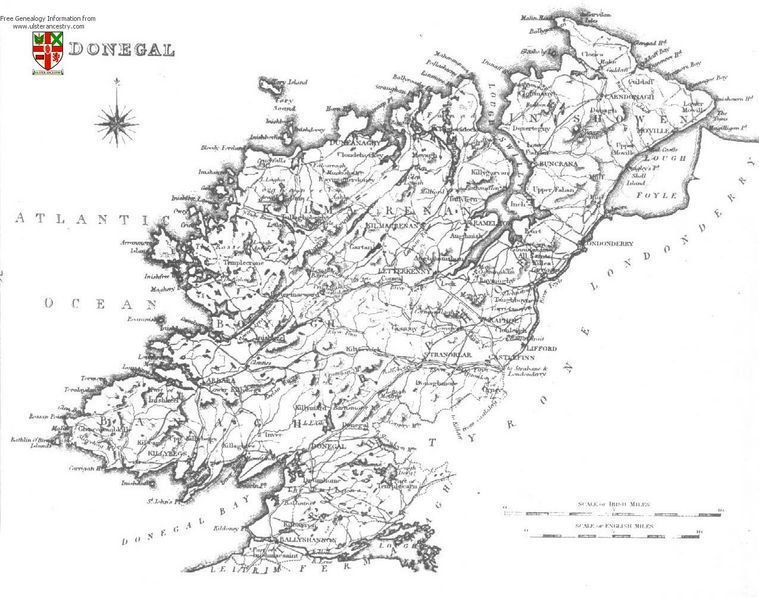
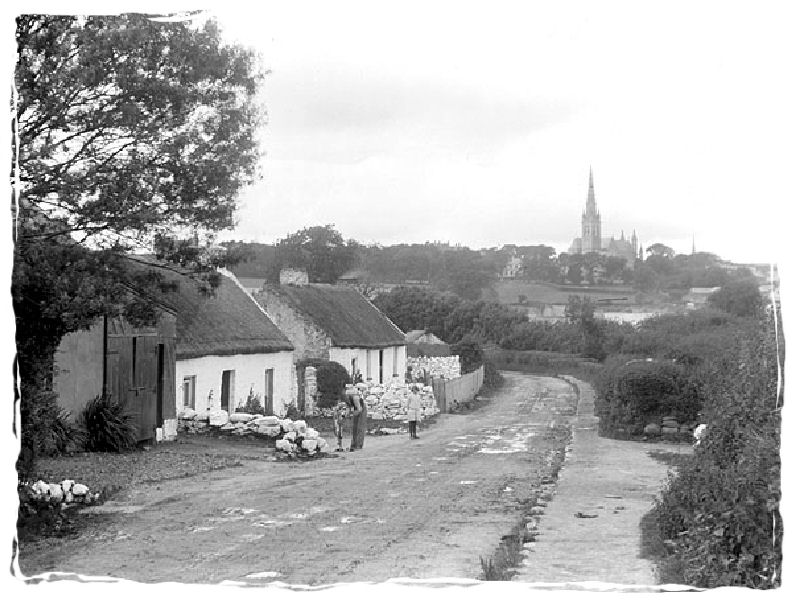
"This is my favorite picture of Letterkenny, Ireland. It's the way I picture it. Someday, when I visit, I am going to walk down this road."
"Here, an early map of Donegal, Ireland. Typed in red is where Letterkenny is. It's centrally located and at the end of the Swilly River"
< Letterkenny

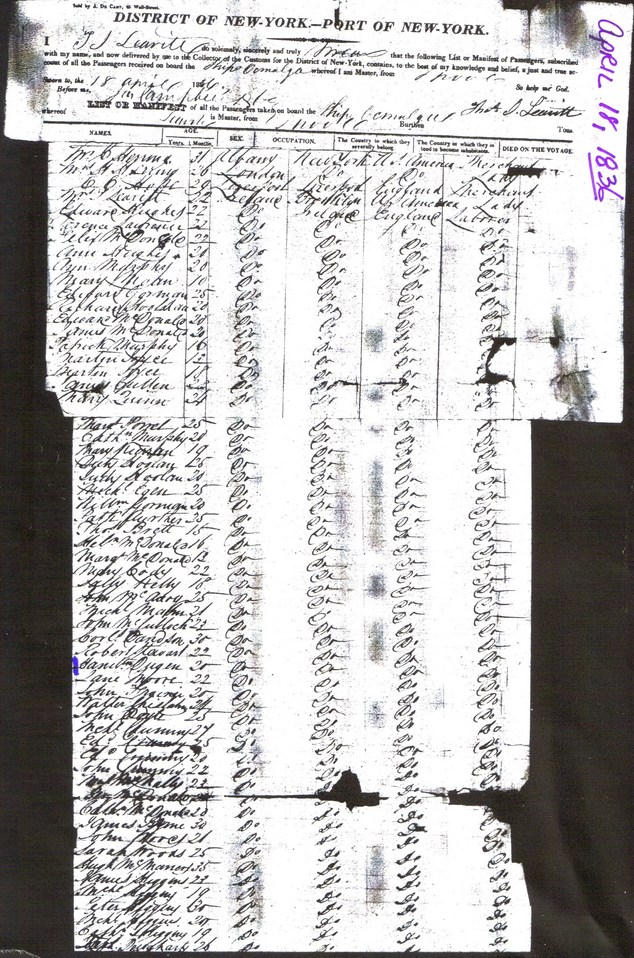
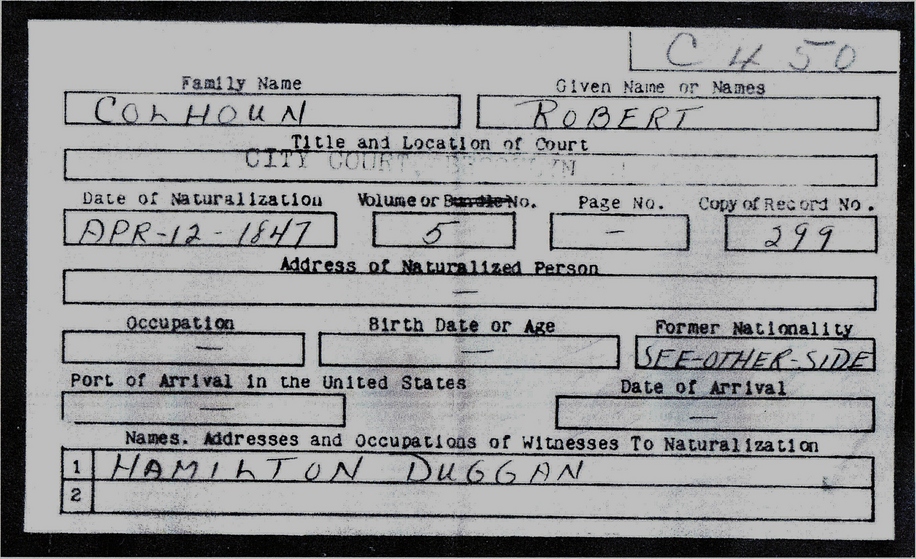
IN THE BEGINNING...WELL......HOW ABOUT 20 YEARS AFTER THE BEGINNING! AT LEAST FOR NOW!
Hamilton Duggan married Euphemia Kennedy on September 28, 1835. Euphemia Kennedy, daughter of John and Margaret Kennedy, was born in Aberdeen, Scotland around 1813. Hamilton would have been around 21 years old and Euphemia around 20 years old. I found two civil war pension documents and both say they were married on September 28, 1835. However, one said married in Letterkenny, Ireland by Rev. Joseph Ligel and the other said married in Aberdeen, Scotland by a Rev. William Littell. Both had the same date, so it leaves me with a mystery to solve. Where were they really married? You can review all of these civil war pension documents under the Civil War Pension tab. Both of these documents were found at the National Archives in Washington, DC and ordered online through http://archives.gov.
While I am on the topic, I can't say enough about the National Archives. They were very helpful when I visited in both Washington, DC and the Northeast Regional office in New York City. I also should mention that the Letterkenny Central Library has been very generous with their help. They were able to confirm that there was indeed a Rev. Joseph Ligel in Letterkenny at the time of Hamilton and Euphemia's marriage, but there were no records of their marriage. They informed me they had all the records from the Letterkenny Presbyterian Church, years 1790 to the present, none had been destroyed. It leaves me thinking they probably were married in Aberdeen, Scotland. No luck yet finding any records, but will let you know when I do.
Hamilton Duggan married Euphemia Kennedy on September 28, 1835. Euphemia Kennedy, daughter of John and Margaret Kennedy, was born in Aberdeen, Scotland around 1813. Hamilton would have been around 21 years old and Euphemia around 20 years old. I found two civil war pension documents and both say they were married on September 28, 1835. However, one said married in Letterkenny, Ireland by Rev. Joseph Ligel and the other said married in Aberdeen, Scotland by a Rev. William Littell. Both had the same date, so it leaves me with a mystery to solve. Where were they really married? You can review all of these civil war pension documents under the Civil War Pension tab. Both of these documents were found at the National Archives in Washington, DC and ordered online through http://archives.gov.
While I am on the topic, I can't say enough about the National Archives. They were very helpful when I visited in both Washington, DC and the Northeast Regional office in New York City. I also should mention that the Letterkenny Central Library has been very generous with their help. They were able to confirm that there was indeed a Rev. Joseph Ligel in Letterkenny at the time of Hamilton and Euphemia's marriage, but there were no records of their marriage. They informed me they had all the records from the Letterkenny Presbyterian Church, years 1790 to the present, none had been destroyed. It leaves me thinking they probably were married in Aberdeen, Scotland. No luck yet finding any records, but will let you know when I do.
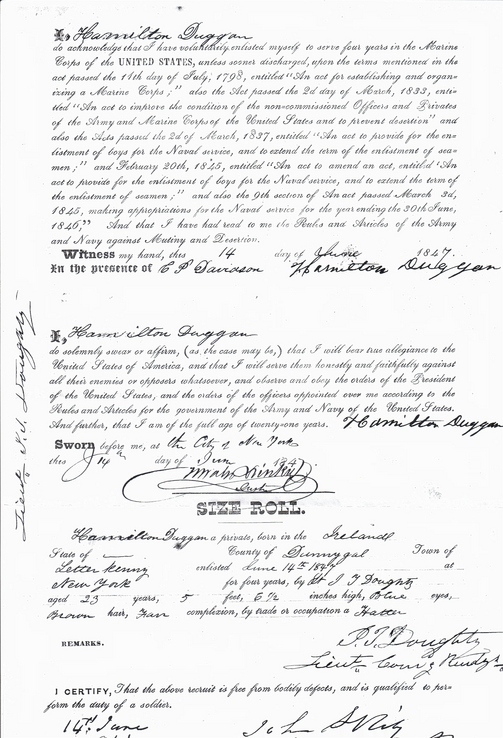
I am going to start with my great, great grandfather, Hamilton Duggan and work my way forward. Don't ask me why but I love the name Hamilton, especially when used as a first name. Has a debonair flair to it. Don't you agree? I tease my kids, telling them that I definitely would have named one of my sons Hamilton had I known. Of course my kids are eternally grateful that I didn't know his name! Maybe I would have spared them and used it as a middle name.
To provide some family background on my great, great, grandfather, Hamilton Duggan, he was born in the townplace of Letterkenny, Ireland around 1814. Letterkenny is located on the Northwest side of Ireland. It sits at the end of the Swilly River. It is located in the Province of Ulster, County Donegal, Barony Kilmacrenan, Diocese of Raphoe and Parish Conwal. Below are a few pictures I found of Letterkenny. Even though these were taken during the 1900's, I think they will still give you a feeling for what Letterkenny was like in the early days.
To provide some family background on my great, great, grandfather, Hamilton Duggan, he was born in the townplace of Letterkenny, Ireland around 1814. Letterkenny is located on the Northwest side of Ireland. It sits at the end of the Swilly River. It is located in the Province of Ulster, County Donegal, Barony Kilmacrenan, Diocese of Raphoe and Parish Conwal. Below are a few pictures I found of Letterkenny. Even though these were taken during the 1900's, I think they will still give you a feeling for what Letterkenny was like in the early days.
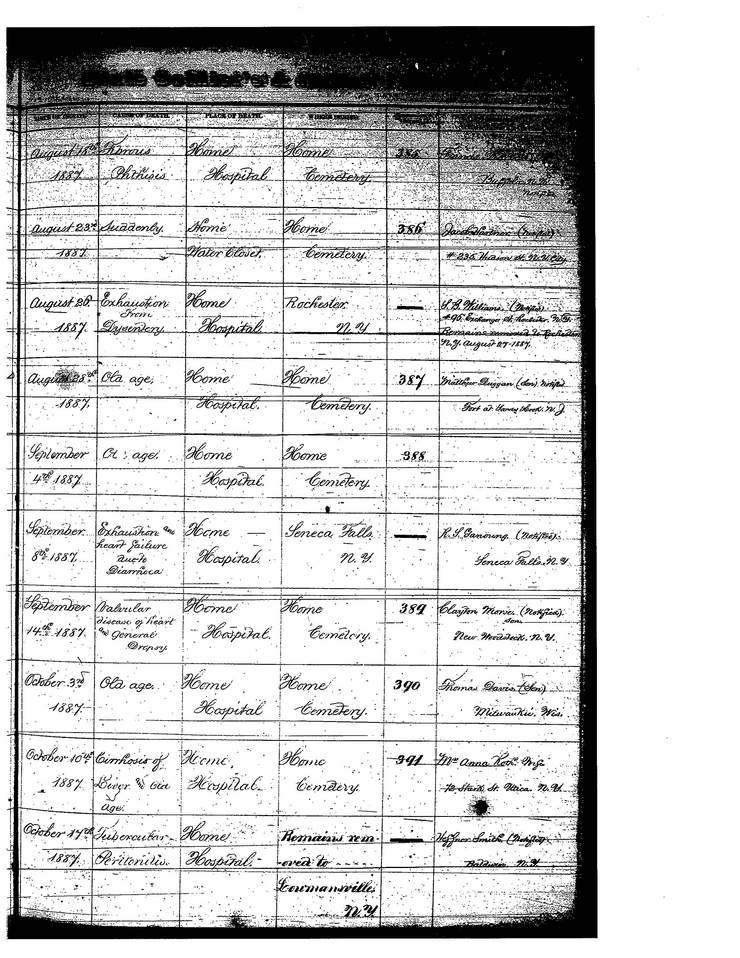
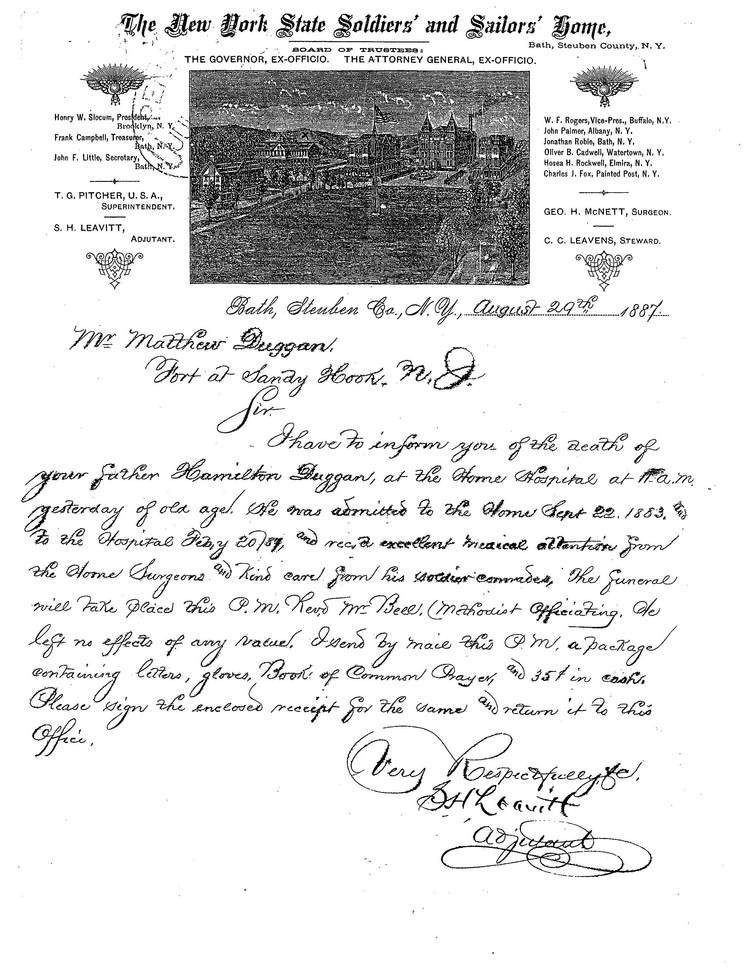

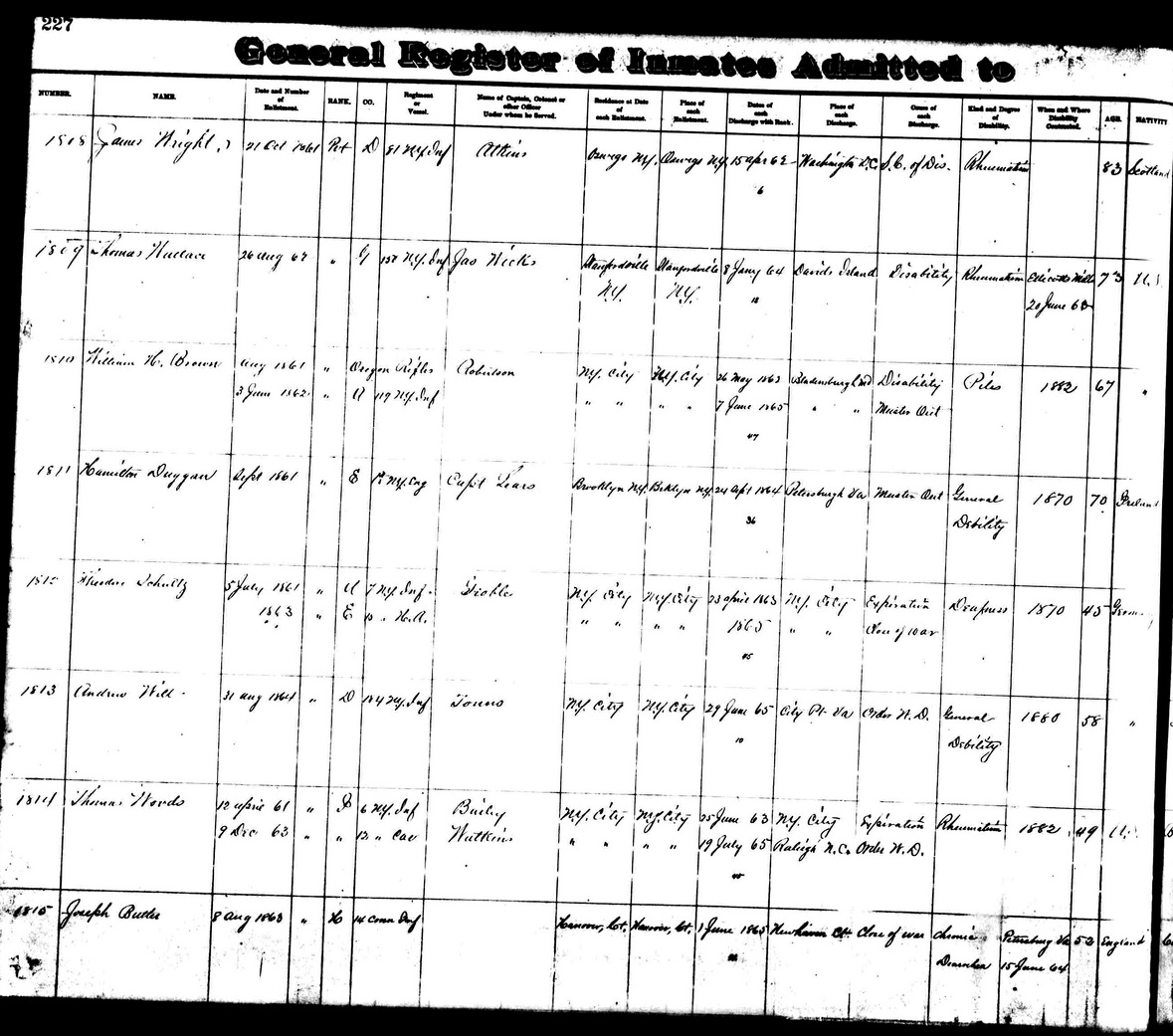
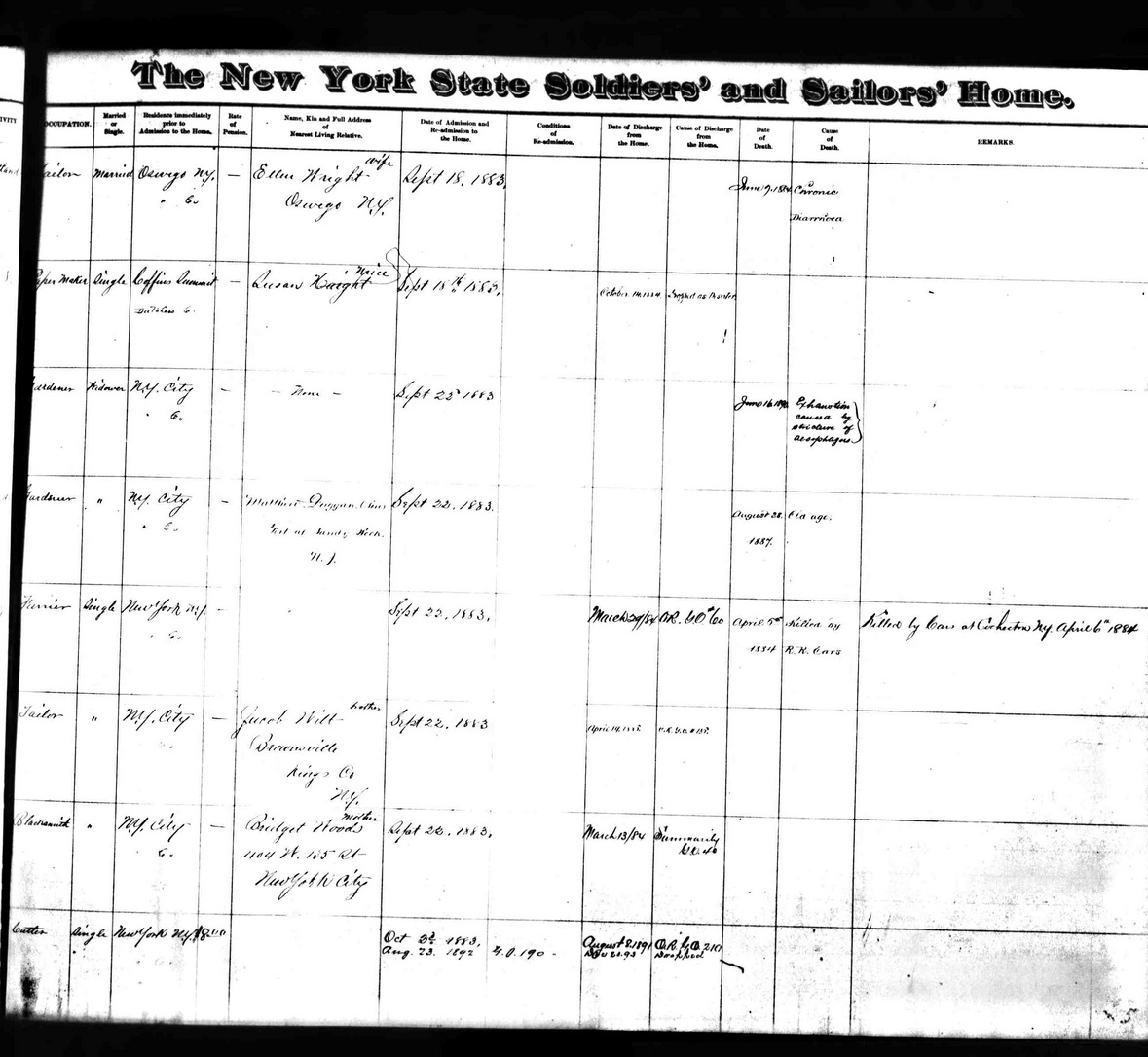
HAMILTON DUGGAN

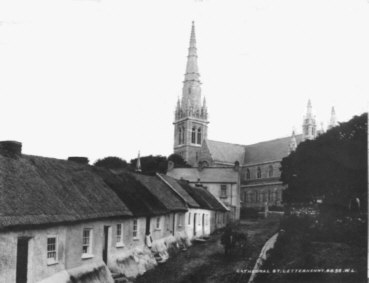
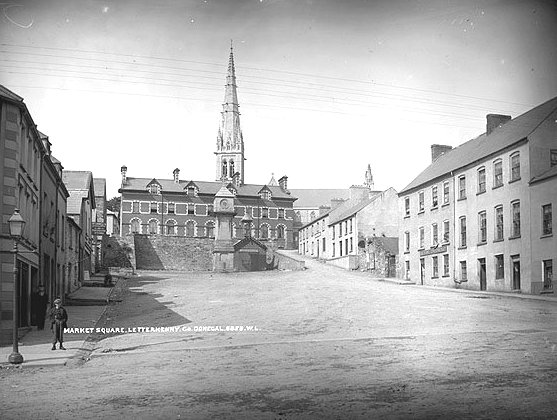
Market Square, Letterkenny, Donegal, Ireland
Letterkenny, Donegal, Ireland
AHOY! ISLAND OF MANHATTAN AHEAD!
Passenger record (left) found on Ancestry.com indicates that Hamilton arrived in New York on April 18, 1836. It shows that he came from Ireland and was 20 years old. Yea I know, how could he have been 21 years old when he got married a year ago and now was 20 years old. If this was his true age he would have been born in 1815-1816, which is slightly off from the 1814 date that other documents indicate. I purposely enlarged his name below so you can find it easier. He shipped out from Liverpool, England on the ship Ocmulgee. His wife Euphemia was not on the passenger list. Either she was omitted, or arrived later on a different ship. Note that they did not spell his name correctly. This apparently was very common during these times. They spelled it as "Hamilton Dugen".
Since you are going to see documents with the name Duggan spelled a few different ways, I am going to take a minute here to explain why I believe this is "our" Hamilton Duggan. I don't want you thinking it was wishful thinking on my part.
Though there were days when that could surely have been the case! Droves of immigrants were coming into New York City during the early 1800's. With them they brought a multitude of languages. Imagine this, our Hamilton Duggan arrives in New York City and upon disembarking from the ship Ocmulgee he is greeted by a gentleman whose job it is to record the name of every person coming off this ship. That man’s homeland was Germany. He hears Hamilton talking with a very strong Irish brogue and what do you think he’s going to do to the name Duggan? That’s right, Durban is born, or something like that! You also had many people arriving that was not schooled and did not know how to spell or write their name. My great, great grandmother Euphemia was one of these. She signed documents with an “x”.
Passenger record (left) found on Ancestry.com indicates that Hamilton arrived in New York on April 18, 1836. It shows that he came from Ireland and was 20 years old. Yea I know, how could he have been 21 years old when he got married a year ago and now was 20 years old. If this was his true age he would have been born in 1815-1816, which is slightly off from the 1814 date that other documents indicate. I purposely enlarged his name below so you can find it easier. He shipped out from Liverpool, England on the ship Ocmulgee. His wife Euphemia was not on the passenger list. Either she was omitted, or arrived later on a different ship. Note that they did not spell his name correctly. This apparently was very common during these times. They spelled it as "Hamilton Dugen".
Since you are going to see documents with the name Duggan spelled a few different ways, I am going to take a minute here to explain why I believe this is "our" Hamilton Duggan. I don't want you thinking it was wishful thinking on my part.
Though there were days when that could surely have been the case! Droves of immigrants were coming into New York City during the early 1800's. With them they brought a multitude of languages. Imagine this, our Hamilton Duggan arrives in New York City and upon disembarking from the ship Ocmulgee he is greeted by a gentleman whose job it is to record the name of every person coming off this ship. That man’s homeland was Germany. He hears Hamilton talking with a very strong Irish brogue and what do you think he’s going to do to the name Duggan? That’s right, Durban is born, or something like that! You also had many people arriving that was not schooled and did not know how to spell or write their name. My great, great grandmother Euphemia was one of these. She signed documents with an “x”.
WHERE, OH WHERE, DID THE NAME HAMILTON COME FROM?
Researching Hamilton Duggan was made a little easier because it was very unusual to find an Irishman who had Hamilton as his first name. To date, I have found only two other Hamilton Duggan’s that lived during the 1800's. One was around the same age and was living in Tennessee. Second one, was born in 1878, Northern Ireland and was married to a woman named Elsie and they immigrated to the USA and settled in New Jersey. Neither one was connected to my Hamilton Duggan. At least, as far as I have been able to tell!
I have a couple of theories on why he was named Hamilton. As I have already said, Hamilton is not a common first name for an Irishman. Knowing that, I am pretty confident that he was not named after anyone in his family. This leaves another possibility. Was he named after someone who was historically important at the time of his birth? Someone I made contact with while researching said that he had spent a lot of time going over Irish birth records from the 1800’s. What he found was there were quite a lot of male babies that were given "Hamilton" as a middle name. It makes sense to me that an Irish family might want to honor someone by naming their son after them. Maybe most used it as a middle name, where as our Hamilton was given it as a first name.
The first famous Hamilton that came to mind was Alexander Hamilton, but the timing was not right. Then there was a John Hamilton of Donegal, 1800 -1884 who was known as the recklessly generous landlord. But again the timing was not right. There was one more and the timing was right. John James Hamilton, First Marquess of Abercorn (1756-1818). The below was taken from the site http://www.jstor.org/. My thought process behind this possibility is if Hamilton was born around 1814, his father would have been born around 1785 and he would have been the right age to be know of and be impressed by John James Hamilton. I think it's a good possibility.
Researching Hamilton Duggan was made a little easier because it was very unusual to find an Irishman who had Hamilton as his first name. To date, I have found only two other Hamilton Duggan’s that lived during the 1800's. One was around the same age and was living in Tennessee. Second one, was born in 1878, Northern Ireland and was married to a woman named Elsie and they immigrated to the USA and settled in New Jersey. Neither one was connected to my Hamilton Duggan. At least, as far as I have been able to tell!
I have a couple of theories on why he was named Hamilton. As I have already said, Hamilton is not a common first name for an Irishman. Knowing that, I am pretty confident that he was not named after anyone in his family. This leaves another possibility. Was he named after someone who was historically important at the time of his birth? Someone I made contact with while researching said that he had spent a lot of time going over Irish birth records from the 1800’s. What he found was there were quite a lot of male babies that were given "Hamilton" as a middle name. It makes sense to me that an Irish family might want to honor someone by naming their son after them. Maybe most used it as a middle name, where as our Hamilton was given it as a first name.
The first famous Hamilton that came to mind was Alexander Hamilton, but the timing was not right. Then there was a John Hamilton of Donegal, 1800 -1884 who was known as the recklessly generous landlord. But again the timing was not right. There was one more and the timing was right. John James Hamilton, First Marquess of Abercorn (1756-1818). The below was taken from the site http://www.jstor.org/. My thought process behind this possibility is if Hamilton was born around 1814, his father would have been born around 1785 and he would have been the right age to be know of and be impressed by John James Hamilton. I think it's a good possibility.
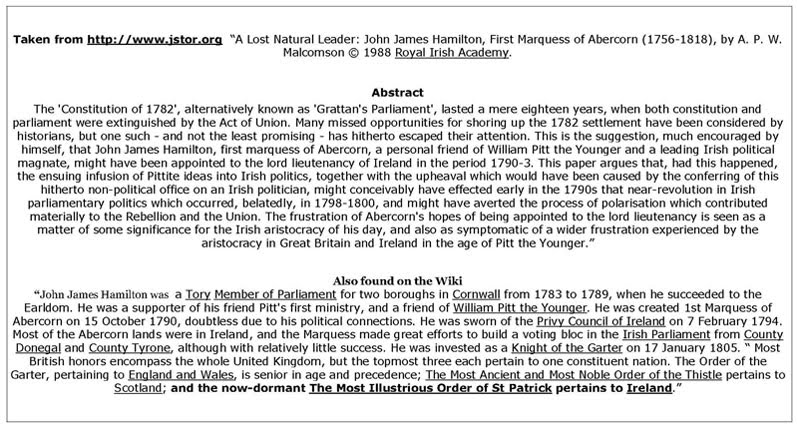
ILLUSTRIOUS ORDER OF ST PATRICK THAT
JOHN JAMES HAMILTON RECEIVED.
JUST IN CASE YOU WERE WONDERING WHAT IT LOOKED LIKE!
JOHN JAMES HAMILTON RECEIVED.
JUST IN CASE YOU WERE WONDERING WHAT IT LOOKED LIKE!
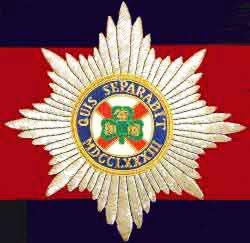
One last theory, yea one more, after all I have given this a lot of thought! The last theory came from a very kind and generous genealogy sleuth, Paddy Duggan from Australia. He is a Motherwell Duggan enthusiastic. You will learn more about Motherwell later on. First let me say that "I believe" Motherwell Duggan is Hamilton’s brother. I haven’t been able to prove it, but I feel it in my bones! Really! Again, we have a first name, Motherwell, which is even more uncommon for an Irishman than Hamilton! They were both born in Letterkenny, Donegal, Ireland. Hamilton born 1814 and Motherwell born 1820. This I have been able to prove. Other than them, I have only been able to find one other Duggan in Letterkenny during this time frame. Her name was Jane Duggan, also born around the same time in Letterkenny. Perhaps she was a sister?
Paddy’s theory is that Hamilton and Motherwell could have been named after towns in Scotland. Well I have to say that after looking at a map of Scotland, I agree that it is a possibility. The towns of Motherwell and Hamilton were right next to each other, connected by a road. In the late 1700’s there was an influx of Scottish to Northern Ireland, they became known as Irish-Scots. It’s possible that Hamilton’s family originally came from Scotland and wanted to commemorate their heritage by naming their sons after the towns they came from. Okay don’t make that face! In genealogy you have to use your imagination to look for leads and I think this is a good one. I personally have to thank Paddy for this idea because I never would have gotten the connection myself.
Another tidbit of information I learned and found interesting was the naming tradition in Ireland at that time. In Ireland it was common (not always) that a child would be named as follows: First son named after the father's father. Second son after the mother's father. Third son after the father. Fourth son after the father's oldest brother. First daughter after the mother's mother. Second daughter after the father's mother. Third after the mother. Fourth after the mother's oldest sister. In this case, Hamilton and Euphemia’s first daughter’s name was Margaret. As it turns out Euphemia's mother's name was Margaret. If we assume they kept to the Irish naming convention can we assume Elizabeth was Hamilton's mother's name? Maybe!
Okay I can see my daughter's expression.....enough on the names Hamilton and Motherwell! Well at least for now!
FIRST TEN YEARS AND COUNTING IN A NEW COUNTRY!
Again from the same civil war pension documents mentioned earlier, I discovered that Hamilton and Euphemia’s had eight children. Matthew between born 1838, Margaret 1843, Elizabeth 1844, Sarah 1847, and Euphemia 1848 were born in Queens County (part is now in Nassau County), Long Island, New York. There were three other children, William born about 1841, Howard born between 1836-1842, and Fanny 1837-1846. My Uncle John Duggan told me he believed they were all born in Oyster Bay, but so far I only have proof that some of them were born in Queens County. According to these papers Matthew was the first born, which leaves us to believe that all their children were born in Queens County. However I am leaving open the possibility that if Euphemia came over later, and that at least one of their children might have been born in Scotland, Ireland or England.
What you will find interesting is, if not for these documents I would not have known that William, Howard and Fanny's existed. So I have yet another mystery to solve! Why did their names not show up on any of the Federal or State Census' that I was able to dig up? Why were they not living with the family? Odd for sure, but not only did those documents tell me that they existed, but told me how old Howard and Fanny were when they died. They were 28 and 32 years of age. Was the information in the pension records not accurate? Why have I not been able to find any trace of them? I will just have to keep on looking....oh and I will!
WHAT ARE FRIENDS FOR?
Interesting document I found (below) while searching on Footnote.com for Hamilton's naturalization papers. It was the naturalization index for Robert Calhoun that I found, which shows that Hamilton was his witness for naturalization.
nce I had the record number I was able to go to the National Archives in NYC and get a copy of Calhoun's naturalization. I tried scanning, but since it was a copy off microfilm (black with white text) it was not cooperating. I was hoping this document was going to lead me to Hamilton's naturalization, but the only benefit I got for finding this document, was Hamilton's signature. It was the same as the signature that was on his enlistment papers (below). So it confirmed they were the same Hamilton Duggan, which is important in the world of genealogy! The date on the document was April 12, 1847, so it looks like Hamilton had just enough time to help a friend, before shipping out on the USS Brandywine. This document also provided me with another lead. Who was Robert Calhoun? Since finding this record I have noticed that there were Calhoun's living in Letterkenny at the same time period as he lived there. There were Calhoun's family living nearby in Orange, NJ and in Bridgeport CT, again at the same time Hamilton and family lived there.....ummm more detective work needed here!
Paddy’s theory is that Hamilton and Motherwell could have been named after towns in Scotland. Well I have to say that after looking at a map of Scotland, I agree that it is a possibility. The towns of Motherwell and Hamilton were right next to each other, connected by a road. In the late 1700’s there was an influx of Scottish to Northern Ireland, they became known as Irish-Scots. It’s possible that Hamilton’s family originally came from Scotland and wanted to commemorate their heritage by naming their sons after the towns they came from. Okay don’t make that face! In genealogy you have to use your imagination to look for leads and I think this is a good one. I personally have to thank Paddy for this idea because I never would have gotten the connection myself.
Another tidbit of information I learned and found interesting was the naming tradition in Ireland at that time. In Ireland it was common (not always) that a child would be named as follows: First son named after the father's father. Second son after the mother's father. Third son after the father. Fourth son after the father's oldest brother. First daughter after the mother's mother. Second daughter after the father's mother. Third after the mother. Fourth after the mother's oldest sister. In this case, Hamilton and Euphemia’s first daughter’s name was Margaret. As it turns out Euphemia's mother's name was Margaret. If we assume they kept to the Irish naming convention can we assume Elizabeth was Hamilton's mother's name? Maybe!
Okay I can see my daughter's expression.....enough on the names Hamilton and Motherwell! Well at least for now!
FIRST TEN YEARS AND COUNTING IN A NEW COUNTRY!
Again from the same civil war pension documents mentioned earlier, I discovered that Hamilton and Euphemia’s had eight children. Matthew between born 1838, Margaret 1843, Elizabeth 1844, Sarah 1847, and Euphemia 1848 were born in Queens County (part is now in Nassau County), Long Island, New York. There were three other children, William born about 1841, Howard born between 1836-1842, and Fanny 1837-1846. My Uncle John Duggan told me he believed they were all born in Oyster Bay, but so far I only have proof that some of them were born in Queens County. According to these papers Matthew was the first born, which leaves us to believe that all their children were born in Queens County. However I am leaving open the possibility that if Euphemia came over later, and that at least one of their children might have been born in Scotland, Ireland or England.
What you will find interesting is, if not for these documents I would not have known that William, Howard and Fanny's existed. So I have yet another mystery to solve! Why did their names not show up on any of the Federal or State Census' that I was able to dig up? Why were they not living with the family? Odd for sure, but not only did those documents tell me that they existed, but told me how old Howard and Fanny were when they died. They were 28 and 32 years of age. Was the information in the pension records not accurate? Why have I not been able to find any trace of them? I will just have to keep on looking....oh and I will!
WHAT ARE FRIENDS FOR?
Interesting document I found (below) while searching on Footnote.com for Hamilton's naturalization papers. It was the naturalization index for Robert Calhoun that I found, which shows that Hamilton was his witness for naturalization.
nce I had the record number I was able to go to the National Archives in NYC and get a copy of Calhoun's naturalization. I tried scanning, but since it was a copy off microfilm (black with white text) it was not cooperating. I was hoping this document was going to lead me to Hamilton's naturalization, but the only benefit I got for finding this document, was Hamilton's signature. It was the same as the signature that was on his enlistment papers (below). So it confirmed they were the same Hamilton Duggan, which is important in the world of genealogy! The date on the document was April 12, 1847, so it looks like Hamilton had just enough time to help a friend, before shipping out on the USS Brandywine. This document also provided me with another lead. Who was Robert Calhoun? Since finding this record I have noticed that there were Calhoun's living in Letterkenny at the same time period as he lived there. There were Calhoun's family living nearby in Orange, NJ and in Bridgeport CT, again at the same time Hamilton and family lived there.....ummm more detective work needed here!
ROBERT COLHOUN'S NATURALIZATON INDEX WITNESSED BY HAMILTON DUGGAN
OH WE'RE IN THE ARMY NOW.....OOPS...... I MEAN U.S. MARINE'S.....ARMY COMES LATER!
Okay are you ready for my pride and joy! I discovered...... (pause for applause)......Hamilton's enlistment papers (below) for the US Naval Marines dated June 14th, 1847. It was truly a memorable day when I found this document. It was on a trip to Washington, DC with my son Joey. He came along to do some site seeing and to humor me, while I did some research at the National Archives. I have to say, for me, it was a unique experience and maybe, just maybe, Joey found it a tad interesting too! I have to admit, that for me, it was a good feeling when I saw an archives employee walking towards me with a document in his hand. I knew I had struck gold! I have to give our National Archives credit for the amazing job they have done taking care of and preserving our historical documents. Ever down there you should check it out.
As I mentioned above, it looks like Hamilton had just enough time to witness Robert Calhoun's naturalization in Brooklyn, New York before he was assigned to the USS Brandywine, stationed at the Brooklyn Navy Yard, and set sail for Brazil Station.
He was away for over three out of the four years he had enlisted for. He arrived back in Brooklyn, New York on December 4th, 1850. Home for Christmas! What a nice present that must have been for his family.
Below is one of my prize possessions! Hamilton's 1847 US Marines enlistment papers.
Okay are you ready for my pride and joy! I discovered...... (pause for applause)......Hamilton's enlistment papers (below) for the US Naval Marines dated June 14th, 1847. It was truly a memorable day when I found this document. It was on a trip to Washington, DC with my son Joey. He came along to do some site seeing and to humor me, while I did some research at the National Archives. I have to say, for me, it was a unique experience and maybe, just maybe, Joey found it a tad interesting too! I have to admit, that for me, it was a good feeling when I saw an archives employee walking towards me with a document in his hand. I knew I had struck gold! I have to give our National Archives credit for the amazing job they have done taking care of and preserving our historical documents. Ever down there you should check it out.
As I mentioned above, it looks like Hamilton had just enough time to witness Robert Calhoun's naturalization in Brooklyn, New York before he was assigned to the USS Brandywine, stationed at the Brooklyn Navy Yard, and set sail for Brazil Station.
He was away for over three out of the four years he had enlisted for. He arrived back in Brooklyn, New York on December 4th, 1850. Home for Christmas! What a nice present that must have been for his family.
Below is one of my prize possessions! Hamilton's 1847 US Marines enlistment papers.
Here is a picture of the USS Frigate Brandywine. It's the only picture I was able to find.
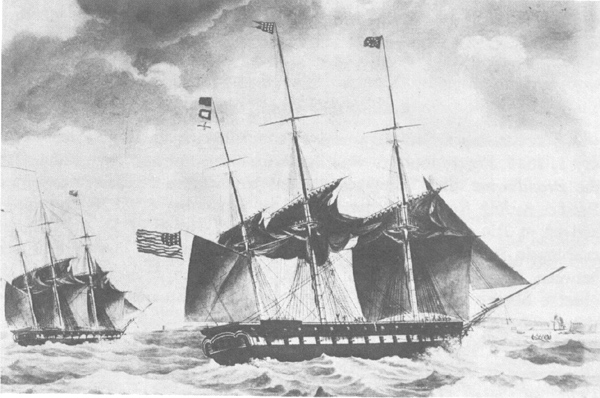
As you look over his enlistment paper, you will see a few interesting details. He was able to sign his name in script, which would indicate that he was educated. It gives his birth place as Letterkenny, Dunnygal, Ireland. The use of Dunnygal, not Donegal, is an indicator that he was probably of Irish-Scottish decent. It gives you a description of what he looked like, 5 feet 6 1/2 inches high, brown hair, fair skinned and, of course, the blue eyes the Duggans are well known for. What catches your attention is it says he is 23 years old. We know this cannot be true since he was born around 1814, married in 1835 when he was 21, arrived in New York when he was 20 years old. A year either way is acceptable when you don't know what month he was born in, or what month the document was created. But how can he be 23 years old? Well he can't be. He was probably around 33 years old. Why he lied I'm not sure. The only thing I can think of is that there might have been age requirements of 25 years and younger in order to join. He lies again later when he enlist in the civil war. There he says he is 39 years old when he was probably around 48. Army age requirements were you couldn't enlist if you were over 40 years old. I have come to learn that it was very common for men to lie about their age in order to join the cause. One more thing I learned from this document was his occupation, prior to enlisting, was a Hatter! Don't you just love it!
I ALWAYS THOUGHT THAT "IN THE OLDEN DAYS" PEOPLE DIDN'T MOVE AROUND MUCH! BOY WAS I WRONG!
Here is an 1850 Federal Census that puts the "Druban" family (highlighted below). Hamilton, Euphemia, Matthew, Margaret, Elizabeth, Sarah and Euphemia in Bridgeport, Connecticut. (No William, Howard or Fanny)
I ALWAYS THOUGHT THAT "IN THE OLDEN DAYS" PEOPLE DIDN'T MOVE AROUND MUCH! BOY WAS I WRONG!
Here is an 1850 Federal Census that puts the "Druban" family (highlighted below). Hamilton, Euphemia, Matthew, Margaret, Elizabeth, Sarah and Euphemia in Bridgeport, Connecticut. (No William, Howard or Fanny)

From the 1850 Federal census, dated August 14th, 1850, I know that Euphemia had moved the family from Queens, New York To Bridgeport, Connecticut. They spelled Duggan as "Druban". Even though Hamilton did not return on the USS Brandywine until December 1850, his name is shown on the census, with his occupation shown as "seaman", which indicates his service in the US Naval Marines.
Euphemia is shown as being born in Ireland, which was an error. She was born in Scotland. Here you see the ages of everyone living at home. Hamilton 35, Euphemia, 36, Matthew 12, Margaret 10, Elizabeth 8, Sarah 5 and Euphemia 3. It also shows that all children were born in New York and were attending school. Not shown are William, Howard and Fanny.
Why they moved to Bridgeport, Connecticut while Hamilton was still away I have no idea!
COULD BE WE HAVE A MAD HATTER OR TWO IN THE FAMILY!!!!
Hamilton's 1847 enlistment papers say his occupation was a Hatter. Knowning that, I have to assume that he was a Hatter while he was living in Queens, because all the documents I have say that their children were born during the 1840's in Queens, New York. Whether he learned the hat trade here in the states, or learned it in Ireland I don't know. Matthew's Army 1858 enlistment papers show his occupation, prior to enlisting, was a Hatter. This would indicate that he either learned the trade while he living in Bridgeport, Connecticut or later in Orange, New Jersey. If Hamilton returned home in December 1850, Matthew would have been around 13 years old, the perfect age to start learning a trade. Perhaps Hamilton taught his son Hat making.
The family moved again, this time to Orange, Essex County, New Jersey. But this time I know why. Orange, New Jersey was where the major Hat Manufacturers were located.
Looking at the 1860 Federal Census (below) it shows that Hamilton is employed as a Hatter in Orange, New Jersey. It also shows his personal assets amounted to $100, was born in Ireland, age 47. His daughter Elizabeth, 18 years, is also shown as a hat trimmer.
Euphemia is shown as being born in Ireland, which was an error. She was born in Scotland. Here you see the ages of everyone living at home. Hamilton 35, Euphemia, 36, Matthew 12, Margaret 10, Elizabeth 8, Sarah 5 and Euphemia 3. It also shows that all children were born in New York and were attending school. Not shown are William, Howard and Fanny.
Why they moved to Bridgeport, Connecticut while Hamilton was still away I have no idea!
COULD BE WE HAVE A MAD HATTER OR TWO IN THE FAMILY!!!!
Hamilton's 1847 enlistment papers say his occupation was a Hatter. Knowning that, I have to assume that he was a Hatter while he was living in Queens, because all the documents I have say that their children were born during the 1840's in Queens, New York. Whether he learned the hat trade here in the states, or learned it in Ireland I don't know. Matthew's Army 1858 enlistment papers show his occupation, prior to enlisting, was a Hatter. This would indicate that he either learned the trade while he living in Bridgeport, Connecticut or later in Orange, New Jersey. If Hamilton returned home in December 1850, Matthew would have been around 13 years old, the perfect age to start learning a trade. Perhaps Hamilton taught his son Hat making.
The family moved again, this time to Orange, Essex County, New Jersey. But this time I know why. Orange, New Jersey was where the major Hat Manufacturers were located.
Looking at the 1860 Federal Census (below) it shows that Hamilton is employed as a Hatter in Orange, New Jersey. It also shows his personal assets amounted to $100, was born in Ireland, age 47. His daughter Elizabeth, 18 years, is also shown as a hat trimmer.
What was a delight was finding the site www.hatindustryatorangenj.com. Not only did it show Hamilton as a Hatter, but I also found his daughter, Elizabeth, who was shown as a Hat trimmer. Also listed were a Daniel Duggan and his wife Elizabeth Duggan, who I am hoping to tie into my Duggan family tree. Always something to work on in genealogy!
You probably didn't want to know, but....hat making was the essential industry in Orange, New Jersey in the 1800's and can be traced back to 1792. By 1892, 21 firms were engaged in that trade, employing over 3,700 people in plants valued at nearly $1.1 million. Nearly 4.8 million hats left Orange that year alone, bound for all four corners of the globe. By 1921, however, only five firms were left, and by 1960, all had departed for places such as Norwalk and Danbury, Connecticut. Now aren't you glad you have that tidbit of trivia!
Okay well here's some more! The term "mad as a hatter" will forever be linked to the madcap milliner in Lewis Carroll's classic children's book, Alice in Wonderland. But few actually know that the true origin of the saying relates to a disease peculiar to the hat making industry in the 1800s. A mercury solution was commonly used during the process of turning fur into felt, which caused the hatters to breathe in the fumes of this highly toxic metal, a situation exacerbated by the poor ventilation in most of the workshops. This led in turn to an accumulation of mercury in the workers' bodies, resulting in symptoms such as trembling (known as "hatters' shakes"), loss of coordination, slurred speech, loosening of teeth, memory loss, depression, irritability and anxiety -- "The Mad Hatter Syndrome." The phrase is still used today to describe the effects of mercury poisoning, albeit from other sources.
Mad Hatter Symptons were a result of their :
—neurological damage, as well as confused speech and distorted vision…hallucinations
—paralysis, loss of memory, mental derangement
—colds, coughs, bronchitis, pneumonia, consumption and the mercury shakes
—problems “affecting the mouth and alimentary canal and the nervous and muscular
systems…the great scourge of the felt-hatting industry is induced tuberculosis of the lungs.”
—”soreness of the gums, offensive breath, increase in the amount of spittle and trembling of
the fingers”
—”mercurial salivation and stomatitis”
—”swelling and ulceration of the gums, loosening of teeth, faster breathing, an excess flow
of saliva, and tremors of the upper extremities.”
I have no proof that Hamilton or Matthew had this disease, but it is possible. Especially Hamilton since had spent years breathing in those toxic fumes.
THE RED COATS ARE COMING!
Okay let’s get to the nitty gritty! It looks like the Duggan family's time together was short lived. The Civil War broke out and on September 25, 1861. Hamilton who was living in New Jersey, enlisted out of Newark, New Jersey, but joined the First Battalion of New York Engineers.
As I mentioned earlier, Hamilton shaved nine years off his age when joining the Army. He said he was 39 years old when he really probably 48 years old. The same thing happened in 1847 when he joined the US Marine’s, he made himself younger than he was. In reading Civil War history I found that it was very common for this to happen, since you would not be accepted if you were 40 years of age or older. However, that wouldn't explain why he would have made himself younger when enlisting in US Marines in 1847.
The documents below outlines Hamilton's service record while in the 1st Engineers Battalion of N.Y.
You probably didn't want to know, but....hat making was the essential industry in Orange, New Jersey in the 1800's and can be traced back to 1792. By 1892, 21 firms were engaged in that trade, employing over 3,700 people in plants valued at nearly $1.1 million. Nearly 4.8 million hats left Orange that year alone, bound for all four corners of the globe. By 1921, however, only five firms were left, and by 1960, all had departed for places such as Norwalk and Danbury, Connecticut. Now aren't you glad you have that tidbit of trivia!
Okay well here's some more! The term "mad as a hatter" will forever be linked to the madcap milliner in Lewis Carroll's classic children's book, Alice in Wonderland. But few actually know that the true origin of the saying relates to a disease peculiar to the hat making industry in the 1800s. A mercury solution was commonly used during the process of turning fur into felt, which caused the hatters to breathe in the fumes of this highly toxic metal, a situation exacerbated by the poor ventilation in most of the workshops. This led in turn to an accumulation of mercury in the workers' bodies, resulting in symptoms such as trembling (known as "hatters' shakes"), loss of coordination, slurred speech, loosening of teeth, memory loss, depression, irritability and anxiety -- "The Mad Hatter Syndrome." The phrase is still used today to describe the effects of mercury poisoning, albeit from other sources.
Mad Hatter Symptons were a result of their :
—neurological damage, as well as confused speech and distorted vision…hallucinations
—paralysis, loss of memory, mental derangement
—colds, coughs, bronchitis, pneumonia, consumption and the mercury shakes
—problems “affecting the mouth and alimentary canal and the nervous and muscular
systems…the great scourge of the felt-hatting industry is induced tuberculosis of the lungs.”
—”soreness of the gums, offensive breath, increase in the amount of spittle and trembling of
the fingers”
—”mercurial salivation and stomatitis”
—”swelling and ulceration of the gums, loosening of teeth, faster breathing, an excess flow
of saliva, and tremors of the upper extremities.”
I have no proof that Hamilton or Matthew had this disease, but it is possible. Especially Hamilton since had spent years breathing in those toxic fumes.
THE RED COATS ARE COMING!
Okay let’s get to the nitty gritty! It looks like the Duggan family's time together was short lived. The Civil War broke out and on September 25, 1861. Hamilton who was living in New Jersey, enlisted out of Newark, New Jersey, but joined the First Battalion of New York Engineers.
As I mentioned earlier, Hamilton shaved nine years off his age when joining the Army. He said he was 39 years old when he really probably 48 years old. The same thing happened in 1847 when he joined the US Marine’s, he made himself younger than he was. In reading Civil War history I found that it was very common for this to happen, since you would not be accepted if you were 40 years of age or older. However, that wouldn't explain why he would have made himself younger when enlisting in US Marines in 1847.
The documents below outlines Hamilton's service record while in the 1st Engineers Battalion of N.Y.
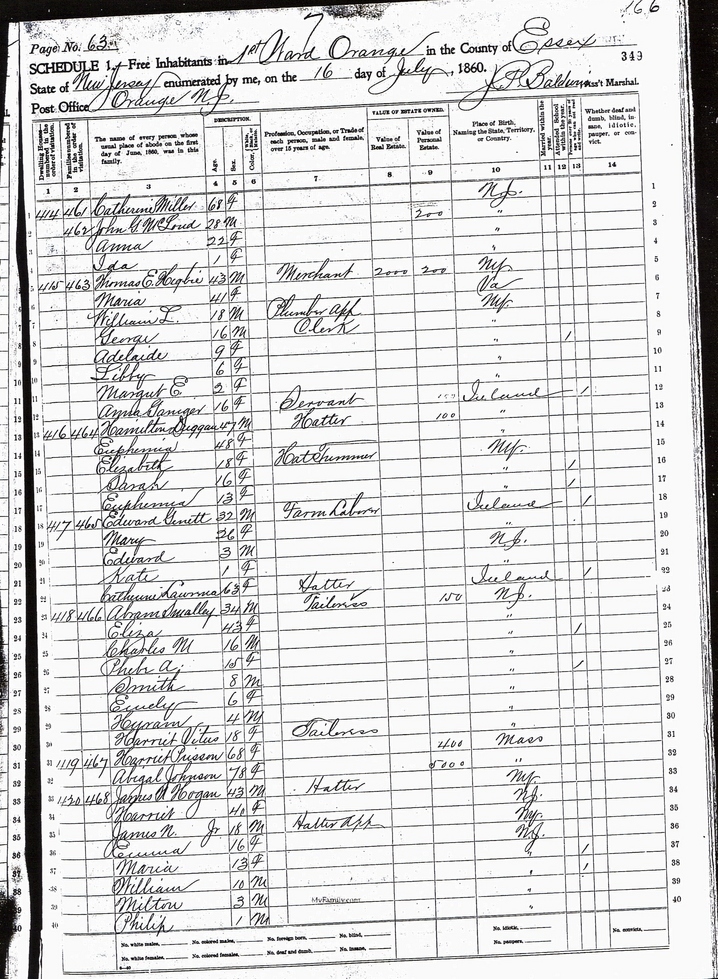
His service record above mentions that he was reduced from Corporate Artificer, then promoted to Corporal, then reduced to Artificers again, and then finally reduced to private. I do not have a clear understanding of why he would be promoted and then demoted. I plan to learn more about the military during this time period. Regardless of what this document says, the below document speaks to his character. I was ecstatic when I found it!
Meaning of Artificer:
1. a skilled craftsman
2. a clever or inventive designer
3. (Military) a serviceman trained in mechanics
Meaning of Artificer:
1. a skilled craftsman
2. a clever or inventive designer
3. (Military) a serviceman trained in mechanics
I have copies of the directories for Newark, New Jersey for the following years: 1864, 1865, 1867, 1868, 1870, 1872 and 1873. Some were not clear enough to add.
THE LAST CHAPTER
Not much is known about Hamilton until Sept 22, 1883 when he was admitted to the NYS Soldiers and Sailors home in Bath, Steuben County, New York. Papers filled out (below) when entering the home list his last occupation as “Guardsmen” and that he had a general disability upon being admitted. I haven't had any luck yet finding what the occupation "Guardsman" would have been in 1883 ... but I'm still looking! I mean he wasn't a spring chicken by this point, so I don't see how it could have been anything military, like the national guardsman, but stranger things have been known to happen.
Page 1 of 2

Hamilton died at the NYS Soldiers and Sailors home on August 28, 1887 and is buried in the Bath National Cemetery.
Below is an index showing Hamilton's arrival at the home and his death
The document below is from the NYS Soldiers' and Sailors' Home to Hamilton's son Matthew, who was stationed at the Fort at Sandy Hook, New Jersey, notifying him of his father's death. Note Hamilton's belongings that were sent to his son. Book of Pray, gloves, some letters and 35 cents.
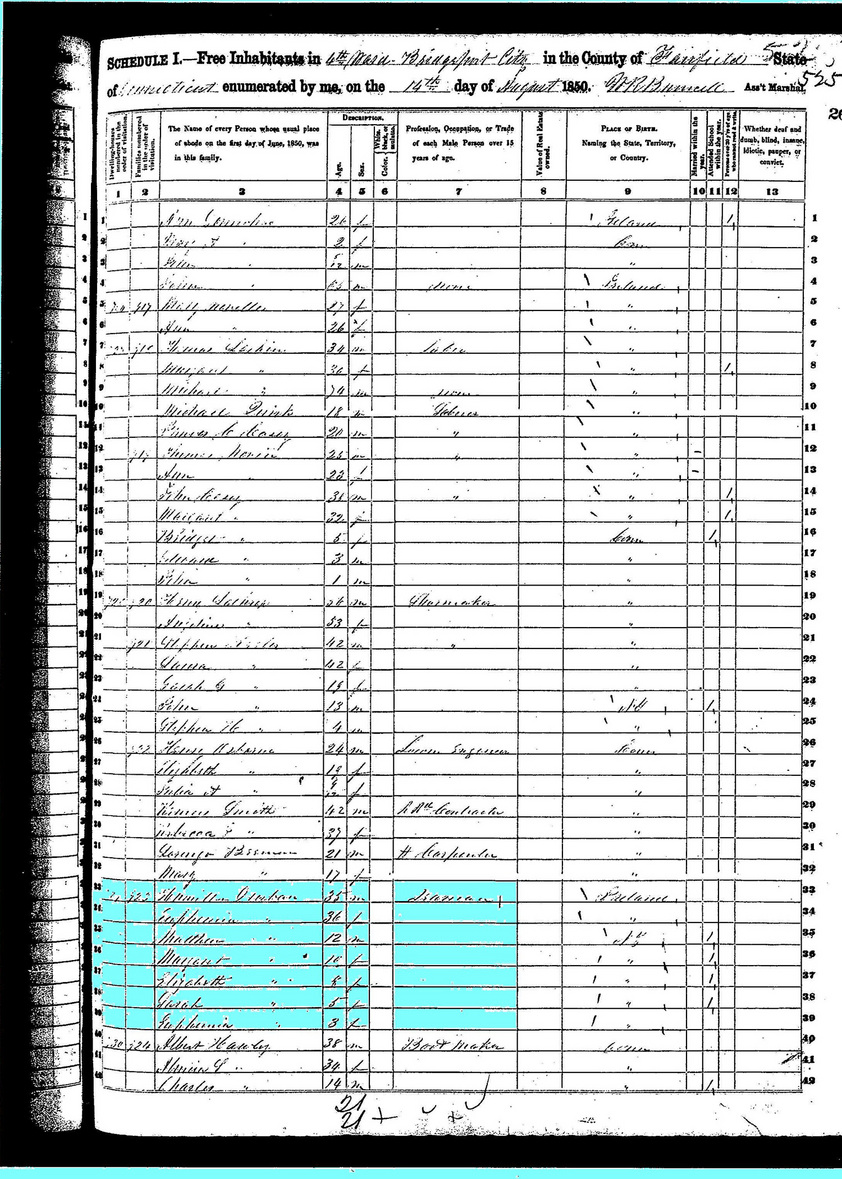

1864 Newark Directory shows Hamilton and family living together
1868 Newark Directory show Hamilton and Euphemia "Effie" living apart....by just a few blocks!
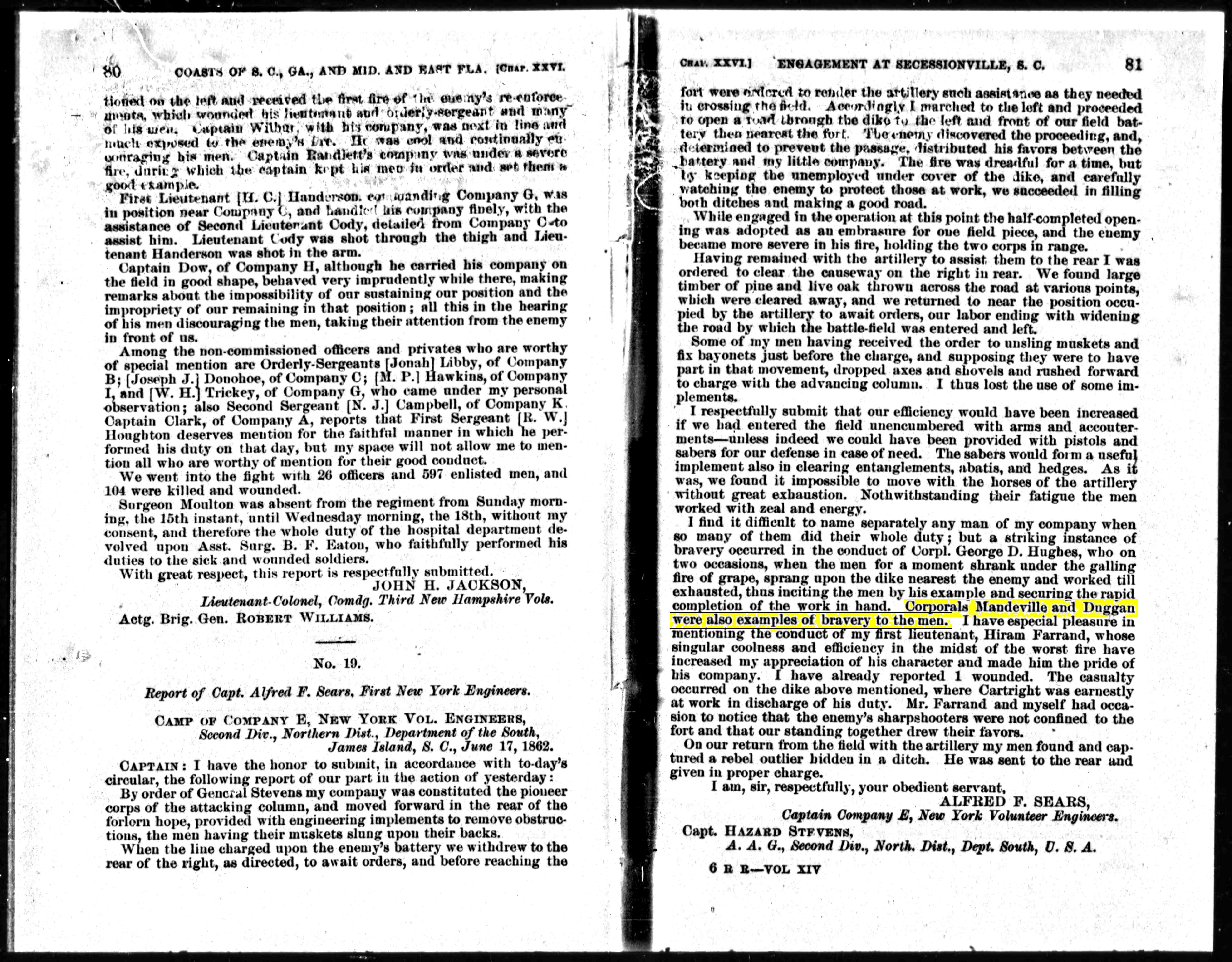
Isn't this great!
I will be putting Hamilton's complete Civil War Service record and story under a separate tab "Civil War Records".
I will be putting Hamilton's complete Civil War Service record and story under a separate tab "Civil War Records".